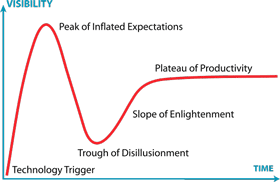“Where do I start?” is the question I get asked most by attendees of the MarketingSherpa B2B Marketing Summit in San Francisco. Marketing Automation is still very new for many companies, and it’s not immediately obvious how you can get started step-by-step. In this post I listed 8 ideas to address this question (and feel free to share yours in the comments!).
Choose Your Products and/or Business Unit
If you start doing marketing automation or lead nurturing, first focus on the most attractive subset of your prospects. For example, focus on a particular product or market segment with a high value. SAGE Publications, one of the presenters at the conference, has many business units with different marketing needs. They first focused their marketing automation efforts on academics who pick the text books for their classes, because winning over one teacher could mean selling hundreds of text books.
Make Sure You Have Enough Leads
An often made mistake is to nurture too small a database. If your problem is lack of raw leads, first address that problem. Genoo, another presenter, used Social Media to fill their prospect database, primarily leveraging LinkedIn Groups and LinkedIn Answers.
Set Your Goals
What is going to make your boss really happy? Is it more qualified leads, a higher percentage of marketing-sourced opportunities, better ROI on marketing investment, customer loyalty, or something else? Pick the most important one and make sure you deliver. The presentation of Ness Technologies clearly pointed out that the CFO can spend money in many ways: make sure you can justify the CFO’s investment in marketing.
Describe Your Lead Flow
Leads go through various stages, from new leads to existing customers. In each stage the follow-up may be different. Find out in which stage marketing can contribute most in the short term. Tom Hayden from SAGE Publications created a flowchart that guided discussions in the entire organization, from the sales teams to the CEO. It was used to gain consensus and set the right priorities.
Improve Your Data Quality
Marketing automation only works if you clean up junk leads, merge all duplicates, normalize company names, and verify all contact information. Additionally, enriching the data with the prospect’s interests makes it possible to better target your campaigns. National Instruments, another presenter at the MarketingSherpa conference, used website behavior to enrich the prospect profile and personalize lead nurturing campaigns.
Create Some Good Content
The key ingredient for lead nurturing is high-quality content, not about your solution itself, but about the broader issues that it addresses. Although more content is better, you can already start nurturing with a few pieces of good content. For example, Ness Technologies used 3 well-chosen content assets to run an entire campaign.
Make Sales Happy Quickly
Improved marketing will drive better-quality leads to sales, but it takes time and trial-and-error to get there. Create some goodwill by giving sales some quick results, for example a tool that alerts them when prospects visit the website. Or give them more background information on prospects: how did they find the website, which pages did they visit, what whitepapers did they download, and so on.
Don’t Worry About Failure
Okay, this may sound a little strange, but failure is not a big issue in online marketing. Just recognize it and change course and soon as possible. You can measure results fairly quickly, so use this information to learn as you go.
MarketingSherpa B2B Summit Comes Recommended
What impressed me about this conference is how well the speakers were selected. In this post I’ve only mentioned a couple of speakers, but all speakers brought up very relevant issues, and creative solutions to common marketing problems. If you’ve missed this conference, you can still attend the B2B Marketing Summit in Boston on October 5 and 6.
I’d love to hear your tips to get started with marketing automation: please let me know in the comments.

